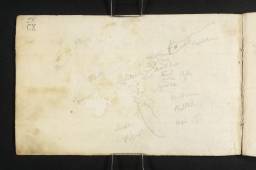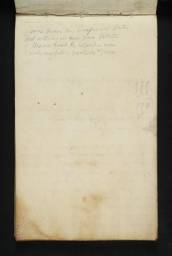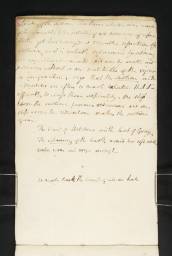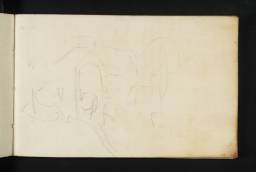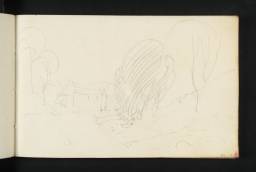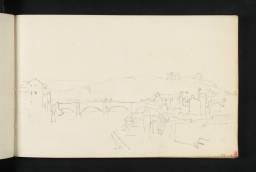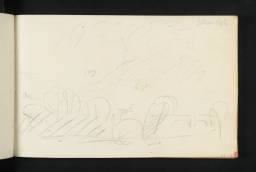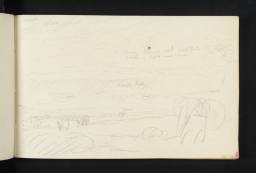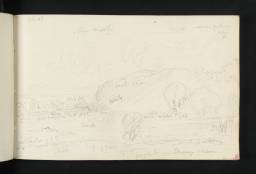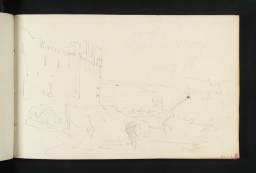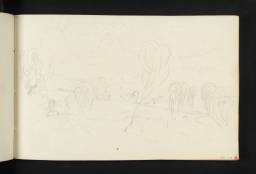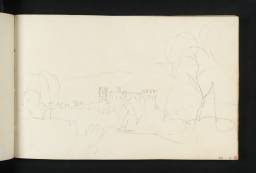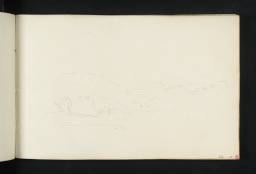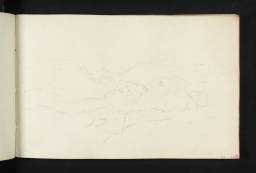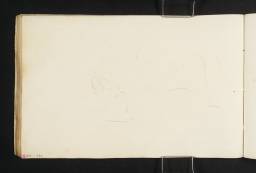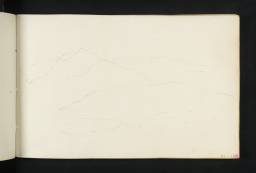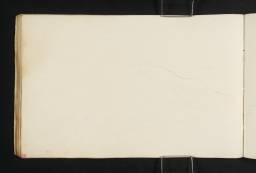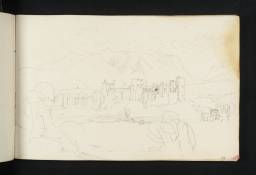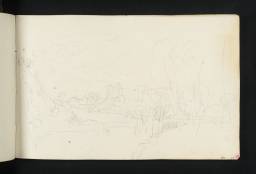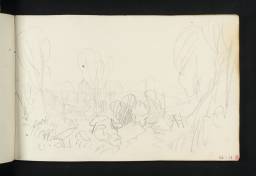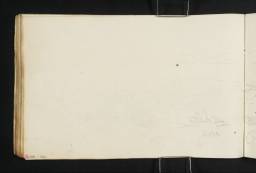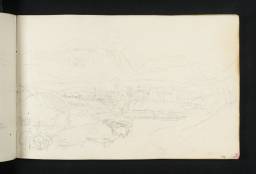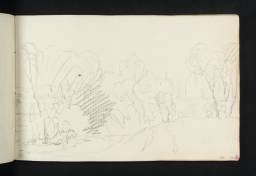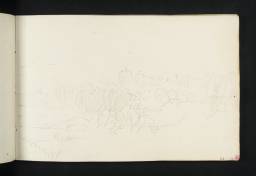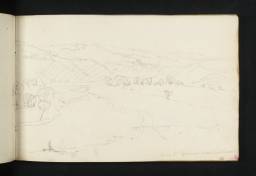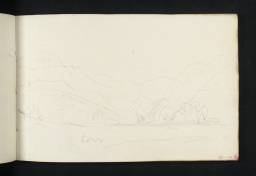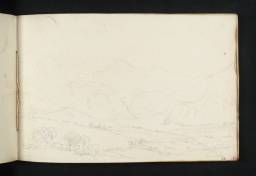Turner Bequest CX
Pocket book, in paper covers faced with blue paper
46 leaves of white laid paper
Approximate page size 116 x 185 mm
Made by William Phipps at Crabble Mill, River, Kent, and watermarked with fleur-de-lys and ‘1802’, and countermarked ‘W PHI...’
Inscribed by Turner in ink ‘104 Cockermouth’ on a label on the spine and ‘57’ and stamped in black ‘J.M.W.T’ on outer back cover (D40744)
Endorsed by the Executors of the Turner Bequest in ink ‘No.172’ and signed by Henry Scott Trimmer and Charles Turner in ink ‘H S Trimmer’ and ‘C Turner’, and initialled by Charles Lock Eastlake and John Prescott Knight in pencil ‘C.L.E’ and ‘JPK’ on a label on outer front cover
A further endorsement by John Ruskin is recorded by Finberg: ‘172 Inven. Cockermouth. Nearly valueless’
46 leaves of white laid paper
Approximate page size 116 x 185 mm
Made by William Phipps at Crabble Mill, River, Kent, and watermarked with fleur-de-lys and ‘1802’, and countermarked ‘W PHI...’
Inscribed by Turner in ink ‘104 Cockermouth’ on a label on the spine and ‘57’ and stamped in black ‘J.M.W.T’ on outer back cover (D40744)
Endorsed by the Executors of the Turner Bequest in ink ‘No.172’ and signed by Henry Scott Trimmer and Charles Turner in ink ‘H S Trimmer’ and ‘C Turner’, and initialled by Charles Lock Eastlake and John Prescott Knight in pencil ‘C.L.E’ and ‘JPK’ on a label on outer front cover
A further endorsement by John Ruskin is recorded by Finberg: ‘172 Inven. Cockermouth. Nearly valueless’
Accepted by the nation as part of the Turner Bequest 1856
Exhibition history
References
Turner took this small pocket book with him to the north-west of England in summer 1809, having been commissioned by the Earl of Egremont to paint his Cumberland seat, Cockermouth Castle, and by the Earl of Lonsdale to paint Lowther Castle, near Penrith. Despite Ruskin’s dismissal it is full of interest and information. It contains views of Cockermouth, Egremont and Penrith Castles; Whitehaven including Whitehaven Castle, the Lonsdale house there, St Bees and Calder; a map marked with places of interest and a possible itinerary of the return journey as far as Manchester; and scraps of Turner’s poetry and aesthetic and literary commentaries. The Cockermouth and Egremont views anticipate those from the dismembered Petworth sketchbook used the same year (Tate D07512–D07536; D40276; Turner Bequest CIX). Those around Penrith or Lowther overlap with the contemporary Lowther sketchbook (Tate D07853–D07957; D40811; Turner Bequest CXIII), and of Whitehaven and the adjacent coastline with the Lowther and Kirkstall Lock sketchbooks (Tate D12240–D12260; Turner Bequest CLV).
The conjunction of subjects in Kirkstall Lock confirms the inclusion of Yorkshire in this tour, and in ?August 1809 Turner wrote from Cassiobury Park, the Earl of Essex’s estate near Watford (also drawn in Kirkstall Lock), saying that he would be there for a week and then ‘upon the wing to Yorkshire for 2 months’.1 Although his main objectives lay west of the Pennines, Yorkshire must have been his first stop and the most likely reason a visit to Walter Fawkes at Farnley Hall for the shooting; Turner had visited Farnley in 1808 and did so again in 1810, his visits becoming almost annual. Stanley Warburton argues that Turner went directly north to Cockermouth, but the evidence of the present sketchbook suggests a roughly circular route beginning around Penrith, just north of Lowther. Folio 6 (D07544) has a distant view of Cross Fell perhaps taken from near the Eden or Leamont rivers, which would have attracted the artist for their excellent fishing. Among subjects newly identified here are views of Penrith Castle, folios 8, 10 and 11 (D07546, D07548, D07549).
Turner must have gone from Penrith to Cockermouth, thence south-west to Whitehaven, pausing to look along Ennerdale (for example folio 25, D07566). He made a small circular trip along the coast to St Bees and then turned south again to Egremont. He sketched a rough map of the region south-west of Cockermouth inside the front cover of the book (D07537), noting places of interest, and drew the coastline around St Bees Head. Opposite, on folio 1 (D07538), he planned the beginnings of his route home: ‘Tuesday E[gremont] Ulv[erston] | Wednesday Whitewell | Thursday Manchester’. Views of Millom Castle in the Petworth and Sandycombe and Yorkshire sketchbooks (Tate D07534, D07535; Turner Bequest CIX 22, 23 and Tate D08975, D08976, D08978, D08998, D09001; Turner Bequest CXXVII 9, 9a, 11, 23a, 25a) show that he must have kept to the coast road, crossing Duddon Sands to the Barrow Peninsular. Then he would have crossed Lancaster Sands in Morecambe Bay for Lancaster, before taking the route through the Trough of Bowland to Whitewell. The schedule seems tight and he may have allowed himself more time.
Turner’s drawings of Lowther are not here but in his Lowther sketchbook and other collections (principally the Ashmolean Museum, Oxford). That he went there first was surely not just a consequence of geography but also an indication of the importance he attached to Lord Lonsdale’s commission.2 It is sometimes implied that this was an addition to an expedition mainly undertaken for Lord Egremont, who then introduced Turner to Lonsdale. But while there are certainly numerous drawings of Cockermouth in this and the Petworth sketchbook, the number of subjects of Lonsdale interest here and elsewhere is significant. Turner must have gone to Whitehaven at Lonsdale’s behest, for the town and port had been developed by the Lowther family to service the mining industry from which it derived much of its fortune. On folio 39 of this sketchbook (D07581), Turner drew Whitehaven Castle, the Lonsdale residence in the town, as rebuilt by Robert Adam; perhaps a painting of this too had been mooted. Moreover outside the Turner Bequest, from a dismembered sketchbook, is a particularly interesting group of detailed pencil drawings of the port and industrial activities around Whitehaven; that they left Turner’s possession has raised the possibility that they were acquired by Lonsdale himself.3 St Bees, the subject of several drawings (for example folio 35, D07577), was the original home of the Lowther family and Millom was also a Lonsdale property at this time.
Turner took the larger Petworth sketchbook as well as this one on his northern tour, but he used them differently. With a few exceptions, the sketches in this book are first impressions. He had already been to Cockermouth briefly in 1797 but now made a survey of the castle, moving around the building and looking out over the River Derwent ‘from Lord Egremont’s room’ (folio 22, D07562). The spectacular ruined castle, a historic possession of the Earls of Northumberland, had passed in 1750 with the Egremont title and Petworth to Sir Charles Wyndham, the father of Turner’s patron. For many years, only a couple of rooms in the outer gatehouse were habitable, but having decided to spend July and August at the castle, Egremont built the so-called ‘Wyndham Rooms’ within the north wall of the outer bailey, 1802–5. Although these are much changed, only the hall and staircase remaining as built, it is still possible to recognise Turner’s view from a first-floor window. It confirms that he had access to the castle and strongly suggests that he stayed there. For Turner, the good fishing to be had in the Derwent would have been a bonus, and his view on folio 22 shows a jetty built out from the ‘Lands’ (the best side for fishing) beneath the castle walls. A sketch in the Lowther sketchbook (Tate D07941; Turner Bequest CXIII 56) inscribed ‘Lord Egremont’ shows a man fishing from what could well be the same jetty; if so it would be proof that Turner’s patron was in residence.
Like Petworth, the castle is close to the town and Turner found his best views from the north or north-west, and across the Derwent rather than the Cocker which Finberg believed appears in many of the drawings. One, folio 16 (D07555), and a more finished version from the Petworth sketchbook (Tate D07536; Turner Bequest CIX 24) served as the basis for the picture Cockermouth Castle (Tate T03879; displayed at Petworth House).4 The picture was ready for Turner’s Gallery in 1810. Although ordered at the same time, it was not painted as a pendant for the larger Petworth, Sussex, the Seat of the Earl of Egremont: Dewy Morning (Tate T03880; displayed at Petworth House). Butlin and Joll suggest that it was matched instead to Egremont’s Thames at Eton (Tate T03873; displayed at Petworth House) as it is the same size. Another possibility, arising from the views of the Earl’s other Cumbrian property, Egremont Castle, is that there was a plan to pair pictures of the two castles. However, Egremont is less striking and well-preserved, as Turner’s drawings show. This sketchbook contains sketches of it from various angles, folios 26–30 and 36 (D07567–71, D07578) and there are more finished versions in the Petworth sketchbook, but it was never painted.
One more picture exhibited at Turner’s Gallery in 1810 originated in this book. Moving south from Whitehaven Turner passed through Calder and as well as visiting the ruined Cistercian abbey (folios 31, 32, D07572, D07573), walked along the footpath to the old packhorse bridge across Friar Gill to make a detailed drawing (folio 33, D07575) for Calder Bridge, Cumberland (private collection).5 It is extensively inscribed with notes, as are other drawings in the book. Many relate to colour and effect and are sometimes expressed in shorthand, by numbers or initial letters, or occasionally quite poetic as when a sky is likened to ‘Blood’ or smoke to clouds. Other notes on local costume or working implements are more down to earth, but have been interpreted as indicating the artist’s ‘sense of cultural distance’ in Cumberland, almost as if he were in a foreign country.6
The most tantalising piece of writing is the book is a scrap of verse about an impending financial crisis, ‘fast telling on my poor estate’, written near the itinerary on folio 1. No such situation existed at Lowther or Cockermouth or (yet) at Farnley and it has been suggested that Turner had worries of his own. However, hardly three miles from Whitewell, Turner’s proposed Wednesday stop, is Browsholme Hall, then home to his patron Thomas Lister Parker and another possible port of call. Conceivably Turner is commenting on Parker’s habitual extravagance, which later compelled him to sell pictures (including one by Turner) and even the house. While the passage seems personal and particular, if not to Turner then to someone known to him, other inscriptions in the book convey wider reflections on aesthetic theory, whether Thomas Paine’s ‘tolerable definition’ of the Sublime, stressing its dangerously close proximity to the ridiculous, folio 1 verso (D07539) or the relationship between poetry and painting.
In a short verse, Turner cites ‘The beard of Hudibras and the Bard of Gray’ to demonstrate how the ridiculous and Sublime can be exaggerated beyond their bounds; his examples of the two modes are both famous poems, Samuel Butler’s Hudibras (1661) and Thomas Gray’s The Bard (1757). These comments are based on a short article on Gray’s own literary sources in The Monthly Mirror, August 1804, which Turner might have browsed in a patron’s library. Gray’s Ode on a Distant Prospect of Eton College (1742) had been quoted in a review of Turner’s Thames at Eton7 and may have been part of its inspiration. Egremont’s fondness for English poetry and for pictures evoking it has been noted, and may have played on Turner’s mind on this tour to Cockermouth as it did also in Sussex, to judge from the Petworth and Frittlewell sketchbooks. But Turner must be mainly concerned with his own efforts as poet and painter and to develop an intellectual framework for his lectures as Professor of Perspective at the Royal Academy.
Technical notes
How to cite
David Blayney Brown, ‘Cockermouth sketchbook 1809’, sketchbook, August 2009, in David Blayney Brown (ed.), J.M.W. Turner: Sketchbooks, Drawings and Watercolours, Tate Research Publication, December 2012, https://www

